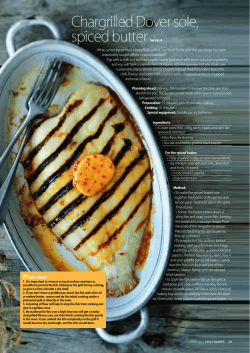
Parasites in Fish
Parasites in Fish • Parasites are a natural occurrence • The parasites do not make the fish “sick” • Thorough cooking of fish will make parasites harmless to humans Organisms of Concern • Roundworms (nematodes) – Anisakis spp., Pseudoterranova spp., Eustrongylides spp. and Gnathostoma spp. Organisms of Concern • Tapeworms (cestodes) – Diphyllobothrium spp. Organisms of Concern • Flukes (trematodes) – Chlonorchis sinensis, Opisthorchis spp., Heterophyes spp., Metagonimus spp., Nanophyetes salminicola and Paragonimus spp How do fish become infected? • Fish become infected when they eat small crustaceans that have consumed parasite eggs or larvae. • Worms migrate to fish muscle or internal organs where they further develop into the stage that can infect humans. Fishborne and other foodborne parasites. Nawa Y et al. Clin Infect Dis. 2005;41:1297-1303 © 2005 by the Infectious Diseases Society of America Anisakiasis • Acute GI disease caused by infection with the herring worm (Anisakis species) or cod worm (Pseudoterranova decipiens) • Source: Raw or undercooked salmon, tuna, herring, mackerel, squid, anchovies, cod, pollack, haddock, monkfish “In North America, anisakiasis is most frequently diagnosd when the affected individual feels a tingling or tickling sensation in the throat and coughs up or manually extracts a nematode.” Anisakiasis • Symptoms: Tickling sensation in throat, abdominal pain, nausea, vomiting, abdominal distention, diarrhea, blood and mucus in stool, and mild fever. • Onset of symptoms occur one hour to two weeks after consuming the roundworm. • Roundworms are usually eliminated spontaneously from the digestive tract lumen within 3 weeks of infection. Anisakiasis • Diagnosis: Fewer than 10 cases are diagnosed annually in the US. • Diagnosis is generally made by endoscopy, radiography, or surgery if the worm has embedded. Or by examination of the expelled roundworm. • Treatment is removal of the worm from the body by endoscopy or surgery (or patient coughs worm out). Diphyllobothrium latum Diphyllobothrium latum • Diphyllobothrium are the largest tapeworms that can infect humans – some can be up to 30 feet long • Source: Raw freshwater or anadromous fish (salmon, trout, perch) Diphyllobothrium latum • Symptoms: Most infections are asymptomatic. – Abdominal discomfort – Diarrhea – Vomiting – Weight loss. – Vitamin B12 deficiency leading to pernicious anemia may occur. – Complications include intestinal obstruction and gall bladder disease caused by migration of proglottids. Diphyllobothrium latum Diphyllobothriasis is rare in the United States, although it was formerly common around the Great Lakes and known as "Jewish or Scandinavian housewife's disease" because the preparers of gefillte fish or fish balls tended to taste these dishes before they were fully cooked. The parasite is now supposedly absent from Great Lakes fish. Recently, cases have been reported from the West Coast. Diphyllobothrium latum • Adult worms can grow as quickly as 1 cm/hour. • The adults can reach more than 10 m in length, with more than 3,000 proglottids. Immature eggs are discharged from the proglottids (up to 1,000,000 eggs per day per worm) and are passed in the feces. Diphyllobothrium latum • Control: Proper cooking of fish • Diagnosis: Diagnosis is made by visual observation of the proglottids and/or eggs under a microscope (eggs are usually numerous, but may require several stool specimens as they are not shed continuously). • Treatment: Medications are available to treat (most often proziquantel or niclosamide) Nanophyetus spp • Nanophyetiasis is the name of the human disease caused by these flukes. • Sometimes called “fish flu”. • Can cause a very serious (sometimes fatal) disease in dogs. Nanophyetus spp • Symptoms: – Increase of bowel movements or diarrhea – Abdominal discomfort – Nausea – Weight loss – Fatigue • Diagnosis: visual observation of eggs in stool • Treatment: can be treated with drugs, however, usually requires multiple rounds of treatment Nanophyetus spp • No reported outbreaks in North America • Is endemic in Russia Nanophyetus spp • North American cases have all been associated with salmonids. • Raw, underprocessed, and smoked salmon and steelhead were implicated in the cases to date. Eustrongylides sp. • Bright red roundworm • Source: freshwater fish, brackish water fish and in marine fish. The larvae normally mature in wading birds such as herons, egrets, and flamingos. Eustrongylides sp. • Larvae can attach to the wall of the digestive tract. • In the five cases for which clinical symptoms have been reported, the penetration into the gut wall was accompanied by severe pain. • The nematodes can perforate the gut wall and probably other organs. accessible areas of the gut. Eustrongylides sp. • The disease is extremely rare; there have been only five cases reported in the U.S. • Those consuming whole minnows are at greatest risk.
© Copyright 2025





















